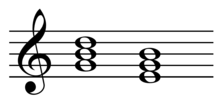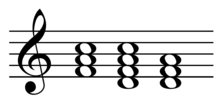
Back Parallelklang German Kontraŭparalelo Esperanto Notas relativas Portuguese Funktionsanalys (musik)#Parallellackord Swedish







Parallel and counter parallel chords are terms derived from the German (Parallelklang, Gegenparallelklang) to denote what is more often called in English the "relative", and possibly the "counter relative" chords. In Hugo Riemann's theory, and in German theory more generally, these chords share the function of the chord to which they link: subdominant parallel, dominant parallel, and tonic parallel.[4] Riemann defines the relation in terms of the movement of one single note:
The substitution of the major sixth for the perfect fifth above in the major triad and below in the minor triad results in the parallel of a given triad. In C major thence arises an apparent A minor triad (Tp, the parallel triad of the tonic, or tonic parallel), D minor triad (Sp), and E minor triad (Dp).
— Hugo Riemann, "Dissonance", Musik-Lexikon[5]
For example, the major and and minor and .
| Major | Minor | ||||
| Parallel | Note letter in C | Name | Parallel | Note letter in C | Name |
| Tp | A minor[6] | Submediant | tP | E♭ major[6] | Mediant |
| Sp | D minor[4][6] | Supertonic | sP | A♭ major[6] | Submediant |
| Dp | E minor[1][4][2][3][6] | Mediant | dP | B♭ major[1][4][6] | Subtonic |
Dp stands for Dominant-parallel. The word "parallel" in German has the meaning of "relative" in English. G major and E minor are called parallel keys. The G major chord and the E minor chord in the key of C major are called parallel chords in the Riemann system.
— [7]
- The tonic, subdominant, and dominant chords, in root position, each followed by its parallel. The parallel is formed by raising the fifth a whole tone.
- The minor tonic, subdominant, dominant, and their parallels, created by lowering the fifth (German)/root (US) a whole tone.
The parallel chord (but not the counter parallel chord) of a major chord will always be the minor chord whose root is a minor third down from the major chord's root, inversely the parallel chord of a minor chord will be the major chord whose root is a minor third up from the root of the minor chord. Thus, in a major key, where the dominant is a major chord, the dominant parallel will be the minor chord a minor third below the dominant. In a minor key, where the dominant may be a minor chord, the dominant parallel will be the major chord a minor third above the (minor) dominant.
Dr. Riemann...sets himself to demonstrate that every chord within the key-system has, and must have, either a Tonic, Dominant or Subdominant function or significance. For example, the secondary triad on the sixth degree [submediant] of the scale of C major, a-c-e, or rather c-e-a, is a Tonic 'parallel,' and has a Tonic significance, because the chord represents the C major 'klang,' into which the foreign note a is introduced. This, as we have seen, is the explanation which Helmholtz has given of this minor chord."
— Shirlaw 2010[8]
The name "parallel chord" comes from the German musical theory, where "Paralleltonart" means not "parallel key" but "relative key", and "parallel key" is "Varianttonart".
- ^ a b c Goetschius, Percy and Faisst, Immanuel (1889). The Material Used in Musical Composition, p.139. G. Schirmer.
- ^ a b Kober, Thorsten (2003). Guitar Works: A Comprehensive Guide to Playing the Guitar, p.136. ISBN 978-0-634-03123-6.
- ^ a b Sebastian Kalamajski (2000). All Aspects of Rock & Jazz, p.35. ISBN 978-87-88619-68-3.
- ^ a b c d Haunschild, Frank (2000). The New Harmony Book, p.47. ISBN 978-3-927190-68-9.
- ^ Gollin, Edward and Rehding, Alexander; eds. (2011). The Oxford Handbook of Neo-Riemannian Music Theories, p.105. Oxford. ISBN 9780195321333. The German text, in the 11th edition of Riemann's Musiklexikon, p. 407, reads: die Sexte des Durakkords und die Untersexte des Moll-akkordes bei fehlender Quinte (für diese eintretend), ergibt den für den betreffenden Klang innerhalb der Tonart stellvertretenden Parallelklang. In C dur entstehen so scheinbar der A moll-Akkord (Tp, d. h. Parallelklang der Tonika, Tonikaparallele), D moll-Akkord (SP) und Emoll-Akkord (DP). (literally: "The sixth of the major chord and the inferior sixth of the minor chord, substituting for the fifth when it is absent, produce the substituting Parallelklang for the corresponding chord in the tonality. In C major in this way arise the apparent A minor chord (Tp, that is the "parallel" chord of the tonic), D minor chord (Sp), and E minor chord (Dp).")
- ^ a b c d e f Gjerdingen, Robert O. (1990). "A Guide to the Terminology of German Harmony", Studies in the Origin of Harmonic Tonality by Dahlhaus, Carl, trans. Gjerdingen (1990), p.xiii. Princeton University Press. ISBN 0-691-09135-8.
- ^ Gail Boyd de Stwolinski Center for Music Theory Pedagogy (1993). Journal of Music Theory Pedagogy, Volumes 5-7, p.37, n.9. School of Music, The University of Oklahoma. What is meant here is that, in the key of C major, G major (the dominant) and E minor (the mediant, the relative of the dominant) are "parallel" (relative) to each other. The same could be said of C major and A minor (the tonic and its relative) and of F major and D minor (the subdominant and its relative).
- ^ Shirlaw, Matthew (reprinted 2010). The Theory of Harmony: An Inquiry Into the Natural Principles of Harmony, With an Examination of the Chief Systems of Harmony from Rameau to the Present Day, p.401. ISBN 1-4510-1534-8. "The Theory of Harmony: An Inquiry into the Natural Principles of Harmony, with an Examination of the Chief Systems of Harmony from Rameau to the Present Day". Archived from the original on 2010-09-01. Retrieved 2010-12-15.

